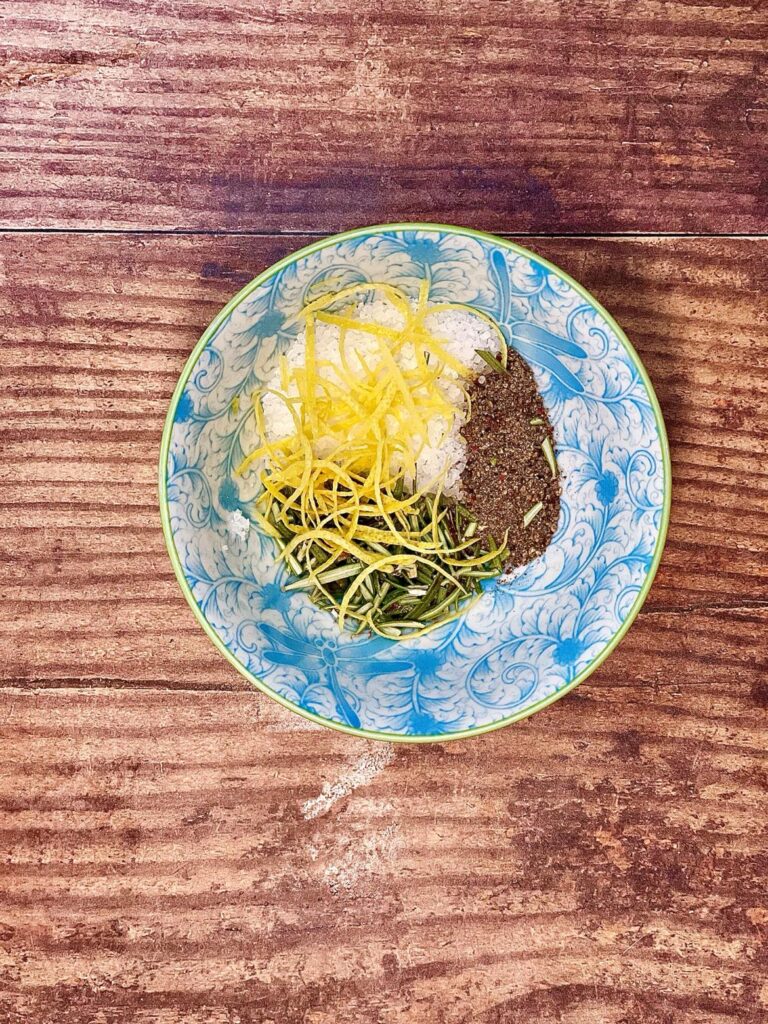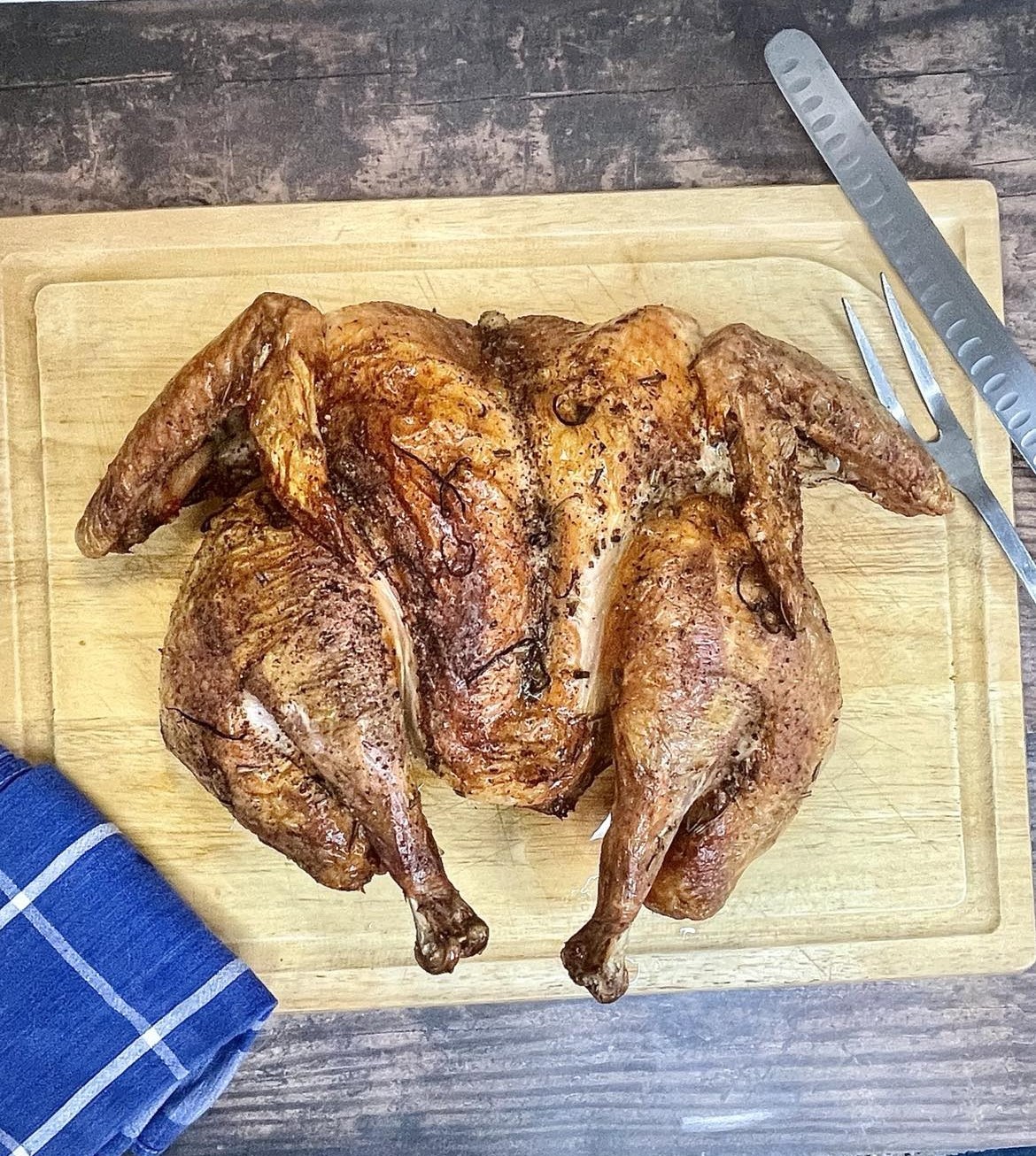
I love roasted turkey! I buy two organic whole turkeys at Thanksgiving, and freeze one to make at another time. It’s been so cold this Spring here in New Jersey, it seemed like a good time to hunker down with some comfort food like roasted turkey.
No turkey? No problem! This works for a whole chicken, which is a lot easier to prepare compared to turkey because the backbone is cut out of the bird, which takes some elbow grease when working with a large turkey.
Instagram Tutorial
Is it Better to Spatchcock a Whole Turkey or Chicken?
I’m not gonna lie. It can be a lot of work on the front end to cut the backbone out, and then the wishbone is cracked to flatten the bird, but these two steps hasten cooking time so much, that it’s worth the effort. The bird will cook evenly, as it roasts in a single layer. It can be a challenge to get a whole turkey to cook uniformly. The breast always seems to dry out before the thighs and turkey bottom are cooked through. Spatchcocking eliminates this problem. Carving is also easier when the bird is flattened out – You don’t have a giant turkey rolling around the cutting board!
What You Will Need for This Spatchcock Dry Brined Turkey
12-14 pound turkey, preferably organic – Not injected with sodium solution or brine
Large Cutting Board
Boning Knife and Kitchen Scissors
Paper Towels
Baking Pan Lined with Parchment and a Wire Baking Rack, plus extra parchment
Dry Brine Recipe (See Below)
½ cup Apple Cider Vinegar
Extra Virgin Olive Oil
How to Spatchcock a Turkey or Chicken
You will need a cutting surface, e.g. a large cutting board, and cutting tools, like kitchen scissors, a boning knife, or both, plus paper towels.
Remove your bird from its’ packaging and use giblets to make gravy, stock, or whatever you normally do after removing those spare parts from under the hood. Pat the turkey dry with paper towels, and place on your cutting surface, breast side down. Locate the backbone, and use kitchen scissors, a boning knife, or both to cut along and remove the backbone. Place the backbone aside to use for stock. Flip the bird and press down to break the wishbone so the bird will flatten. Transfer the bird to a baking rack lined with parchment, and a wire rack.
Now the hard work is done! It’s time to dry brine.
Should I Dry Brine a Whole Turkey or Chicken?
Dry brining is salting and resting the bird so it soaks in some of the salt for flavoring, and ensures a crispy skin. It’s a lot easier than wet brining, as you don’t have liquid sloshing around, and wet brines plus turkey weight can be very heavy to move around from the counter to the refrigerator. Dry brining requires planning ahead, because you want the salt to be on the skin for 24 hours.

For a 13 pound bird, I am dry brining with this mixture:

2 tablespoons course sea salt
Zest of one large lemon
Heaping teaspoon of fresh ground pepper
¼ cup chopped fresh rosemary

Pat turkey skin dry with a paper towel. Mix dry brine ingredients, and sprinkle evenly over turkey skin. Rub brine into turkey skin to distribute it evenly.
Refrigerate uncovered for 24 hours. It’s important that you do not cover the bird because you want the skin to dry out so it will roast up nice and crispy.
Remove from refrigerator after 24 hours. You will notice the skin is dried out, and the turkey flesh will look a little pink underneath the skin from the brining process. This is normal. Some liquid will collect on the parchment.
Preheat your oven to 350 degrees F on convection roast, setting top rack below center to for roasting.
Change out the parchment paper in your baking pan for a fresh piece. Carefully pour ½ cup apple cider vinegar into the bottom of the roasting pan, avoiding the turkey. The apple cider vinegar will steam and make the turkey moist and juicy. If you plan to make gravy with the drippings, skip the apple cider vinegar. Lightly spray the skin with extra virgin olive oil, or pour a tablespoon into your hand and rub on the skin if you do not have a sprayer.
Roast your turkey for about 6 minutes per pound on convection roast, or until the internal temperature achieves 160 degrees F. Be sure to check temperatures in multiple spots. Turn roasting pan 180 degrees about ½ hour into cooking to promote even cooking. Once roasting is complete, remove turkey from rack, place on cutting surface, and allow to rest, tented with parchment for about 20 minutes for the juices to reabsorb into the turkey.

Carve and serve. The skin will be crispy and the turkey meat will be moist and delicious. Use this same method with chicken, adjusting the dry brine amounts accordingly, based on weight of your bird.
How To Grill a Spatchcock Turkey or Chicken
If using a gas grill, set it to medium high, and place turkey or chicken breast side up. Turn down to medium low after five minutes. Grilling time varies from grill to grill. If the outside starts to cook too quickly, finish on indirect heat. For a charcoal grill, use indirect heat, with the dark meat side facing the coals. The instant read thermometer is your friend, and should be used as your guide! Follow temperature and resting instructions from above



 Follow Me On Instagram
Follow Me On Instagram Like My Facebook Page
Like My Facebook Page My LinkedIn
My LinkedIn



